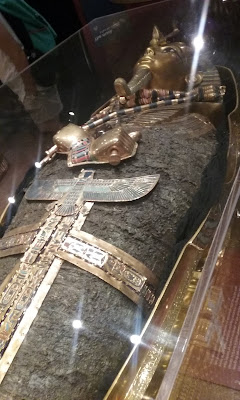In January 2017, while I was on holidays in Perth, I was able
to attend the exhibition of Tutankhamun—His Tomb and His Treasures. The display
began touring the world in 2008, and millions of people in a dozen countries
have seen it. The exhibitions re-created the moments in 1922 when Howard
Carter, an English archaeologist, discovered the boy-king’s tomb, what the
crypt looked like inside, and the recovery of the treasures.
 |
| How the tomb looked when Howard Carter opened it. Possessions stored for the afterlife. |
It was a rare opportunity for me to catch a glimpse of
ancient Egypt in person. All of the artifacts on display were reproductions,
highly skilled ones and valuable. The real grave items stayed at home in Egypt,
and the body of Tutankhamun rests in his tomb in the Valley of the Kings.
The exhibition was innovative and allowed the viewer to walk
up near some of the artifacts as many of them weren’t locked behind glass
panels. Security officers were unobtrusive and discreet. It was a surreal
feeling to be surrounded so closely by tomb objects from timeless Egypt. There
were also some short documentary movies to watch.
When Howard Carter dug a hole in the doorway, and inserted a
candle to have his first look at Tutankhamun’s tomb, he spoke of there being
wonderful things inside. The exhibition was full of gold objects.
 |
| One of the catalogs from the exhibition. |
A lot of care and devotion went into the preparation of
Tutankhamun’s body for his soul's voyage to eternity. His mummy was enclosed within multiple
coffins and held within multiple shrine boxes. Layers of linen and layers of magical
amulets covered his body. His arms were full of bangles. He wore multiple
necklaces. The bandages contained resins and fragrant oils and his mummy
eventually became stuck to the wrappings. On the top most layers of linen,
wreaths and garlands of flowers were placed by his family before he was sealed
inside the sarcophagus.
 |
| The top most sarcophagus of Tutankhamun decorated with flowers. |
 |
| Raising the golden sacrophagus out of the shrine. The wings of goddess Isis wrap the corners of the box in protection. |
Tutankhamun was the boy king from the 18th Dynasty
of the New Kingdom. He was crowned pharaoh at 8 years of age and died at 19,
some 3,300 years ago. He is famous for his tomb treasures rather than for his
reign. If I remember correctly, his name was deliberately erased from Egypt’s
history. His father was the radical pharaoh, Akhenaten. His mother was
Nefertiti or an unknown royal wife. Akhenaten was also removed from the record
because of the unpopular religious upheaval he created.
Tutankhamun's tomb was broken into twice after his burial by grave robbers
and was later re-sealed. Osirius was the ancient Egyptian god of the afterlife.
Deceased pharaohs took on his name for the next journey of their soul, like
this, Osirius-Tutankhamun.
 |
| Statue of the boy-king with the Valley of the Kings in the background. |
His Children
Tutankhamun was married to his sister, Ankhesenamun. It’s believed
he fathered 2 children who didn’t survive their births. Coffin cases were found
for a 5 month old fetus and a still born baby.
Opening of the Mouth
As part of the rituals, the mummy’s mouth was opened to open
the senses (breathing, taste, hearing etc) to the afterlife.
Rebirth of the Mummy
The mummy was laid out on a golden couch decorated with lion’s
heads for the rebirthing rituals. Sekhmet, the lion-headed goddess is the
daughter of the sun god Ra. Ra travelled on his solar boat through the
underworld, and pharaohs were regarded as the sons of Ra.
 |
| Small statues of goddesses and gods. They were anointed with fragrant oils, and wrapped in linen covers. |
The Ba Amulet
Tutankhamun had a large piece of jewelry, an amulet placed
over the middle of his chest so his Ba, the part of him that lived on after
death, his soul, could return to his body at night. Mummification was a process
to slow the physical decay of the body, but it was believed the soul could still
return to inhabit the body, enliven it, and enjoy the worldly possessions
placed in the tomb.
 |
| Winged Ba jewelry placed on Tutankhamun's chest, symbolizing the flight of the spirit and its return to the physical body. |
 |
| The contents of the tomb being carried to the Nile River for transport to Cairo. |
Thanks for reading, and
have a good weekend.
♥ Ashlyn
♥ Ashlyn



No comments:
Post a Comment